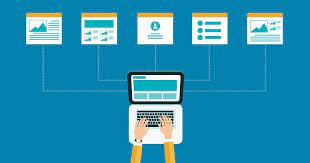Hello!
You’ve created and launched an online store. Excellent! But the market never slows down – it only gets bigger. And it moves fast.
 Indeed, worldwide eCommerce growth shot up by 27.6% in 2020. What’s more, now that the world is returning to normal, post-pandemic forecasts suggest the eCommerce market will increase even more.
Indeed, worldwide eCommerce growth shot up by 27.6% in 2020. What’s more, now that the world is returning to normal, post-pandemic forecasts suggest the eCommerce market will increase even more.
Keeping up with customer demand in such a fast-paced market isn’t easy. Even if you wanted to “stay small”, any online store that wants to survive must look at the bigger picture at some point.
In this article, we’ll be sharing 5 tips that will help you grow your online store at scale so that you’re able to keep up with the fast-paced market.
Why It’s Important To Grow Your Online Store
 Scaling is a huge step that allows you to manage high growth. Costs will eventually rise as you seek (and gain) more customers and invest in new technology.
Scaling is a huge step that allows you to manage high growth. Costs will eventually rise as you seek (and gain) more customers and invest in new technology.
If you don’t grow your store, profits won’t rise alongside costs – and you’ll lose to your competitors.
Growing your store gives you a stronger foundation to continue the momentum, too. This ensures your store is prepared for what’s around the corner because it boosts stability.
For example, Google has shown that site speed is crucial to the customer experience. If your website takes longer than 5 seconds to load, 90% of your customers might bail out and head elsewhere.
Imagine if your website was unable to cope with a surge in demand and crashed when too many customers tried to access it? It could spell disaster.
 What’s more, when you grow your store and invest in new, relevant software and tools, you’ll be able to react to market changes and keep up with your competition and new innovations.
What’s more, when you grow your store and invest in new, relevant software and tools, you’ll be able to react to market changes and keep up with your competition and new innovations.
The more you innovate, the more you’ll be able to fight off your competitors.
The truth is that customers have more options than ever before. If you don’t grow your store to meet customer demand, and if you don’t find new ways to reach them before your competitors, you will ultimately lose out.
5 Tips For Growing Your Online Store At Scale
Now that you know the importance of growing a store, the next step is to implement a series of tactics that will allow you to stay one step ahead of the market.
Let’s take a look at 5 ways you can grow your online store:
1. Create a strong SEO campaign
 SEO is the process of optimizing your online store so that it appears among the top results in Google for specific search terms. It’s important for the success of any online store. It doesn’t just drive organic traffic to your store – a good SEO campaign drives qualified traffic.
SEO is the process of optimizing your online store so that it appears among the top results in Google for specific search terms. It’s important for the success of any online store. It doesn’t just drive organic traffic to your store – a good SEO campaign drives qualified traffic.
In other words, you’ll start attracting potential customers who are actually interested in what you’re selling.
If you’re creating an SEO campaign for the first time, it helps to start by taking an SEO course. There are lots available – including this one by Ahrefs.
Then, you’ll need to invest in SEO tools such as a keyword research tool that helps you find the keywords your customers are using.
It’s also a smart idea to hire an SEO professional to manage your SEO campaign for you.
Other ways to get started with SEO include:
- Create valuable content. This means maintaining a regular blog that helps customers learn more about you and your products. You can share tips and tricks, discuss your brand story, and give insights into your process (do you use sustainable packaging? And so on)
- Optimize your content with keywords. Keywords are the phrases your customers use when they type a search query into Google. For example, “men’s leather jacket under $50” is an eCommerce search term. Use keyword research tools to find the keywords that your customers are using, and then add them to your content
- Optimize your product listings. You need to optimize your product listings in the same way you’ll be optimizing your content. Again, carry out keyword research to learn more about the terms your customers are using, before adding them to your listings.
- Take care of technical SEO. SEO isn’t just content marketing – it’s also technical. In other words, making sure your website runs smoothly. For example, you can run your website through a site speed checker to make sure your pages load quickly. You can also optimize your pages for mobile devices, as well as ensure there are no duplicate content issues.
2. Build a buzz with a marketing campaign
Putting a marketing strategy in place can help you reach more customers which, in turn, boosts sales.
It can also help you to position your brand better, differentiate yourself from your competitors and build strong relationships with your customers. You can also turn prospects into first-time buyers – and then into loyal customers.
 A good marketing campaign can start with SEO. What’s more, much of digital marketing is essentially related to SEO. You’ll need to apply your SEO know-how to your:
A good marketing campaign can start with SEO. What’s more, much of digital marketing is essentially related to SEO. You’ll need to apply your SEO know-how to your:
- Content marketing campaigns
- PPC campaigns
- Optimized product pages
But digital marketing is also much broader than that. It also includes:
- Social media marketing
- Retargeting ads
- Personalized website
You can also invest in affiliate marketing. This is a form of marketing where marketers create content that subtly promotes your brand for you. Each time a customer clicks your link that the affiliate shares in their content and goes on to purchase your products, the affiliate gets a portion of the sale’s proceeds.
 Ultimately, marketing an eCommerce store is far-reaching and you’ll likely be leveraging multiple digital channels to reach more customers. These include:
Ultimately, marketing an eCommerce store is far-reaching and you’ll likely be leveraging multiple digital channels to reach more customers. These include:
- YouTube
At the center of it all must be a customer-first approach that ensures you offer as much value to the end-user as possible. Don’t always go for the sale – instead, nurture your relationships with valuable content.
Respond to comments. Offer advice and solutions that help them. Personalize your website.
3. Double down on customer support
Customer support is “very important” to 61% of your customers. Good customer support gives your customers what they want: faster responses, responses where they’re at, personalization, and convenience. This in turn can boost brand loyalty.
 For example, you could add a chatbot to your website that answers their queries within seconds. Not just that, but an AI-driven chatbot is able to learn more about your customers each time it interacts with them. This allows it to personalize future conversations.
For example, you could add a chatbot to your website that answers their queries within seconds. Not just that, but an AI-driven chatbot is able to learn more about your customers each time it interacts with them. This allows it to personalize future conversations.
And if there’s a tricky question that your chatbot can’t answer, they can pass the customer over to one of your human agents.
You should aim to implement an omnichannel strategy, too.
This means you interact with your customers on different channels, including Facebook, your website, Twitter, and email.
The beauty of this is that you get to meet your customers wherever they are, which means they don’t have to jump through several hoops just to contact you and get a response.
Not just that: the essence of an omnichannel strategy is that your channels – and communications – are integrated. This ensures seamless communication between you and your customers.
For instance, if Customer A asks a question on Channel A and then appears on Channel B to ask another question, your customer service agents will already have detailed information on this customer. This then allows them to provide a faster, more accurate (and personalized) response.
4. Build an email list
 Email is still effective in 2024.
Email is still effective in 2024.
Because email is seen as a more personalized, 1:1 form of marketing, it can connect you with your customers better and help you build strong relationships. This is because you can segment your list and tailor your emails so that each individual only receives content that’s relevant to them and their needs.
It can lead to direct sales as you raise awareness of promotions and discounts, too. Email is also a cost-effective way of growing your online store. Research from the Direct Marketing Association has indeed shown that it can bring in $40 for each $1 spent.
The trick is in a) generating leads in the first place so that people sign-up to your list and b) creating engaging email marketing campaigns that come with good click rates, open rates – and conversion rates.
To build your list, you’ll need an attractive lead magnet. This is essentially an ethical “bribe” in which you give something away for free in exchange for a customer’s email address. This might be a coupon, a discount, or the offer of free shipping.
For instance, Oka entices customers with the option of free delivery on all orders over £150. All they have to do to grab the promo code is enter their email address:
Once your customers are on your email list, your task is to then send them emails that boost engagement.
 Here are some tips:
Here are some tips:
- Thank your new subscribers
- Segment your list so that you only send relevant emails (such as product recommendations) to the right people. This will also allow you to personalize your email content.
- Don’t try to sell something with every email. Raise awareness of your deals and promote your products, but add value too. Mix things up with educational content, links to your latest (or best performing) blog posts, and tips and tricks.
- Add color and images to your emails. Make them pop!
- Research good subject lines. If your subject line isn’t strong enough, your open rates will be down.
5. Work with a 3PL
A 3PL is a third-party logistics partner that can streamline your operations andsimplify your online store. When you work with a 3PL, you get to outsource your entire operational logistics so that your shipping routes are fully optimized.
 This ensures:
This ensures:
- You don’t experience a backlog of orders
- You don’t end up with an inventory nightmare
- Your customers receive their orders on time
- You get top rates on shipping and fulfillment, making operations more affordable
Altogether, you are minimizing risk.
If you’re planning to grow your business at scale, it’s well worth considering working with a 3PL before your customer base expands to the point where you’re overwhelmed with orders.
Moreover, optimizing your supply chain increases stability (important for growth) and it also reduces the risk of something going wrong with shipping or orders (and you catching the blame for it).
As always with anything like this, read customer reviews, ask for referrals, and look for industry awards to get a better idea of a 3PL before you start working with them.
Also read:
- Growing Your Small Business
- What You Need to Know about Oracle BPM Development Services?
- Deal With Homework In 6 Simple Steps
Conclusion
 It’s essential that your growth doesn’t stagnate. You should always be looking at ways to scale so that you stay on top of demand, keep your existing customers happy – and attract new ones.
It’s essential that your growth doesn’t stagnate. You should always be looking at ways to scale so that you stay on top of demand, keep your existing customers happy – and attract new ones.
There are multiple ways you can grow your store.
We’ve examined the top 5 but it’s really important that you put your customers first whatever you do.
Customer-centric businesses are likely to stay one step ahead of the curve, with90% of consumers saying that customer service is a huge deciding factor when it comes to shopping at an online store.
Give value, offer discounts when possible, and build meaningful relationships that ensure you’re always more than just another online store.
Thank you!
Join us on social media!
See you!






